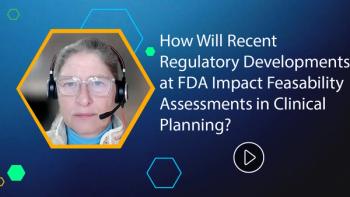
Supply Shortages in Weight Loss Drugs
In this Pharmaceutical Executive video interview, Currax Pharmaceuticals, CEO, George Hampton, discusses factors that are contributing to ongoing supply issues and if prices for these therapies are coming down anytime soon.
Continuing with that theme of access, we’ve seen sporadic supply and shortages of some GLP-1 analogues, including those big names like Ozempic, with some expected to run into 2025. As if that hurdle weren’t enough itself, the price tag of some of these therapies are then substantial. Right now, a monthly package of a GLP-1 costs between $900 and $1,350 before insurance and other rebates. Do you foresee those prices coming down anytime soon? What factors are contributing to these ongoing supply issues?
So let me let me take that in two parts. One is the price because I think that leads to access and some of the availability of product. So, we have for the last almost five years had a program in place called Pure access, pure access. What it does is it kind of avoids all of the middlemen, right all the people who are profiteering in the middle of the healthcare system and allows the patient to access our products directly. For $99/month shipped for free right to their home. We put that in place, because we realized very quickly when we when we bought into when we when we acquired a company, that access and affordability was the number one problem. So, we began working on an affordability program that would allow patients to afford medication. So, $99/month, it is not a permanent program that's going to go on forever. It really is a bridge program to when the healthcare system starts behaving rationally, it actually starts covering, covering obesity as a disease, right. So, we put that in place because it was very obvious. That's a problem.
Lilly came in and did a very similar thing. They have Lilly Direct, and I'm so glad they did, because I think they're the first large pharma company to ever put something in place, it's kind of this direct to patient opportunity to be able to receive the medication at a cash price that goes around some of the profit tiers in the in the middle of the of the system, right? And then and so that's the pricing element of it. Yes, the GLP-1s are very expensive. We saw last week, we saw, you know, this study come out from Yale saying you can make your Novo Nordisk product for $5, why do they cost $1,350? I don't know if I believe that study, I think it's probably very difficult to have a sterile environment where you're filling, you know, very sterile, sterile, expensive glass, putting it into a very complex, you know, pen device, and then putting it in a box, I don't think you can make that product for $5. I would be very, very surprised. Right? I don't think that's the real story. Bernie Sanders came out and said ‘they must lower their price and this is egregious.’ The question really on price for that particular product is why is it the same product as epic? And why does it cost 40% more? And that's the point I was trying to make last week and one of the news channels is that this the question. Pharmaceutical pricing, we know that it's a very complex situation, I think it's somewhat old news. The question is, you know, are foreign companies out there taking advantage of the United States system? And, you know, charging more than they really need to for, what is essentially the exact same product of what they've launched for type two diabetes? Is it disease state specific and weight bias? That is worst. Where you pay more if you're obese and less if you're type two diabetic? Or is it just a just profiteering? And I don't know, the answer is probably better question for that for that company. So, there's the pricing aspect of it.
The second piece, really, to your point is the manufacturing. And this is this is to tell you the type of situation we are in, we only have 5% of all patients in the United States who are eligible for pharmaceutical care for obesity being treated, it's 95% untreated, and two of the primary products that are key to solving this disease will go viens up out are both talking about shortages. Can you imagine if this was hitting the treatment rates that we see with hypertension in the 70s or type two diabetes in the 80% treated range, or we mean it would be impossible to keep up which comes back to my point of we need more therapy as we need more companies in the space, we need more tools for the physicians. When you have more tools, and you have more product competing prices come down. So yes, I see prices coming down. I think if the if our if we can get a vote on the trow bill, the treat and reduce obesity act, we can get a positive vote on that, and obesity is going to be covered. I think we'll see CMS lead the way commercial payers following suit, and other pharmaceutical companies, large pharmaceutical companies coming in to really try to make a difference in this space. And we will, we'll make a very, very positive impact on our obesity disease state here in the United States.
Newsletter
Lead with insight with the Pharmaceutical Executive newsletter, featuring strategic analysis, leadership trends, and market intelligence for biopharma decision-makers.




